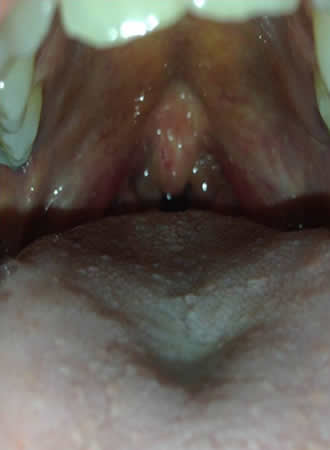History and exam
Key diagnostic factors
common
cough
Usually dry and has been present for at least 8 weeks.
In some patients, the cough may be minimally productive; however, a daily productive cough should prompt consideration of pulmonary pathology (e.g., bronchiectasis).
unpleasant sensation in throat
Key diagnostic feature. Description can vary between people; however, it is typically described as an unpleasant feeling like something is stuck/lodged in, tickling, or irritating the throat.
postnasal drip
Often described as a feeling of mucus dripping from the back of the nose into the throat. Commonly associated with throat-clearing maneuvers.
cobblestone mucosa
Oropharyngeal exam reveals a cobblestone appearance to the posterior oropharyngeal wall and local upper airway structures.[Figure caption and citation for the preceding image starts]: Oropharynx with evidence of generalized edema, enlarged uvula, and some cobblestone change.Image courtesy of Mr Guri Sandhu; used with permission [Citation ends].
Other diagnostic factors
common
nasal abnormalities
Crusting and mucosal edema may be noted.
symptoms of rhinitis
Rhinitis may coexist with upper airway cough syndrome (UACS).
Symptoms include persistent clear nasal discharge, sneezing, and intermittent nasal blockage. Nasal pruritus and conjunctivitis are features of allergic rhinitis.
Unilateral nasal symptoms, facial pain, thick green discharge, recurrent nosebleeds, or persistent loss of smell are not typical features of rhinitis and warrant further ENT assessment.[22]
uncommon
posterior pharyngeal mucus
Oropharyngeal exam may reveal visible mucus in the nasopharyngeal area.
wheeze
Some patients with upper airway abnormalities may have an inspiratory wheeze arising from the glottis.
voice disturbance
Patients may report a change in voice quality (e.g., dysphonia, hoarseness).
heartburn/indigestion
Gastroesophageal reflux may coexist with UACS.
Although these symptoms may be self-reported, it is important to be aware that other features (e.g., cough with phonation, on eating, on bending over, or on first becoming ambulatory in the morning) may indicate atypical reflux as a relevant aggravating factor.
Risk factors
strong
seasonal triggers
Seasonal allergen exposure may be a key trigger and should prompt investigation to determine atopic status to seasonal aeroallergens.
weak
occupational triggers
Certain occupations have been associated with upper airway cough syndrome. Common work exposures associated with occupational rhinitis include laboratory animal workers with allergic rhinitis from laboratory animal allergy or nonallergic rhinitis associated with endotoxin exposure; and bakers with allergic rhinitis to wheat, egg, enzymes, or other high-molecular-weight allergens in a bakery.[17]
female gender
There is a female predominance.[7]
Use of this content is subject to our disclaimer